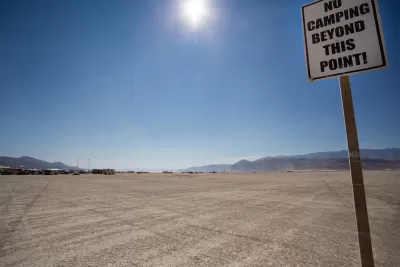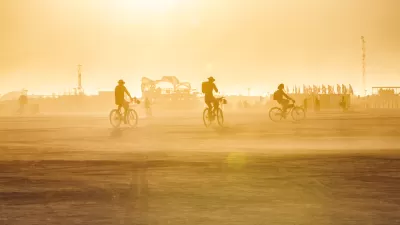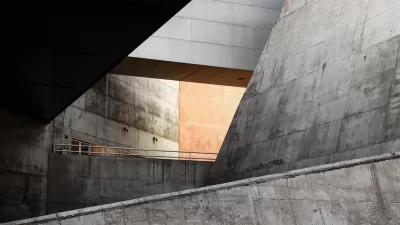Black Rock City is the temporary city initially designed by Rod Garrett in 1997 that springs up for the annual Burning Man festival. Each year the city expands to accommodate more people, but still retains its core utopian characteristics.

Every year, the volunteer Department of Public Works constructs the city in the month before the festival, and volunteers stay for almost two months after to disassemble the colossal installations, and pick up all of the left-over remnants from the festival. Indeed, Burning Man is the largest "Leave No Trace" event in the world. Steve Pepple, a first-time attendee to Burning Man this year, shared his experiences on Medium earlier this week in a piece titled, "What Burning Man Taught Me About Cities."
Amid pressures from a growing population and local regulations, the city plan was created by Rod Garrett, a landscape architect, in 1997. Indeed, the semicircular shape and radial streets are akin to the early 20th century Garden Cities planned by Ebenezer Howard. In addition, "Rachel Bowditch also points out the similarities of Garrett’s design with other utopian city plans, especially Thomas More’s Abraxa Island, which is 'practically interchangeable with the 2001 blueprint of Black Rock City.' The central square or Esplanade of Burning Man is what Garrett, who passed away in 2012, called the 'largest plaza in the world.'"
As Pepple writes, the concentric circles of Black Rock City allow for social interactions, more than efficient transportation or moving of goods, "[t]he culture has shaped the design of the city, not the other way around. The greatness of Black Rock City’s design is in its service to Burning Man’s community and guiding principles."
FULL STORY: What Burning Man Taught Me About Cities

Alabama: Trump Terminates Settlements for Black Communities Harmed By Raw Sewage
Trump deemed the landmark civil rights agreement “illegal DEI and environmental justice policy.”

Study: Maui’s Plan to Convert Vacation Rentals to Long-Term Housing Could Cause Nearly $1 Billion Economic Loss
The plan would reduce visitor accommodation by 25% resulting in 1,900 jobs lost.

Planetizen Federal Action Tracker
A weekly monitor of how Trump’s orders and actions are impacting planners and planning in America.

Waymo Gets Permission to Map SF’s Market Street
If allowed to operate on the traffic-restricted street, Waymo’s autonomous taxis would have a leg up over ride-hailing competitors — and counter the city’s efforts to grow bike and pedestrian on the thoroughfare.

Parklet Symposium Highlights the Success of Shared Spaces
Parklets got a boost during the Covid-19 pandemic, when the concept was translated to outdoor dining programs that offered restaurants a lifeline during the shutdown.

Federal Homelessness Agency Places Entire Staff on Leave
The U.S. Interagency Council on Homelessness is the only federal agency dedicated to preventing and ending homelessness.
Urban Design for Planners 1: Software Tools
This six-course series explores essential urban design concepts using open source software and equips planners with the tools they need to participate fully in the urban design process.
Planning for Universal Design
Learn the tools for implementing Universal Design in planning regulations.
Caltrans
Smith Gee Studio
Institute for Housing and Urban Development Studies (IHS)
City of Grandview
Harvard GSD Executive Education
Toledo-Lucas County Plan Commissions
Salt Lake City
NYU Wagner Graduate School of Public Service




























